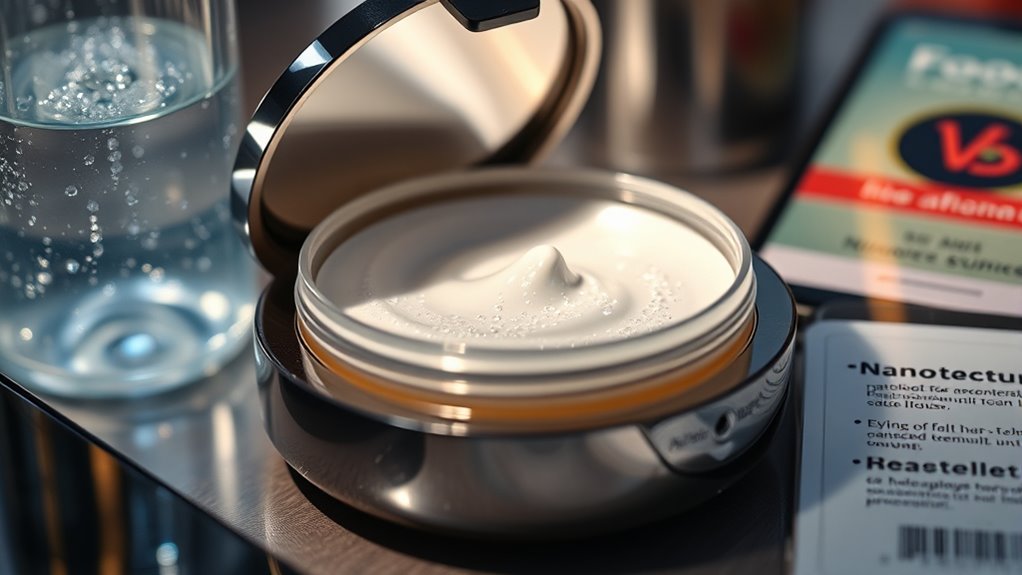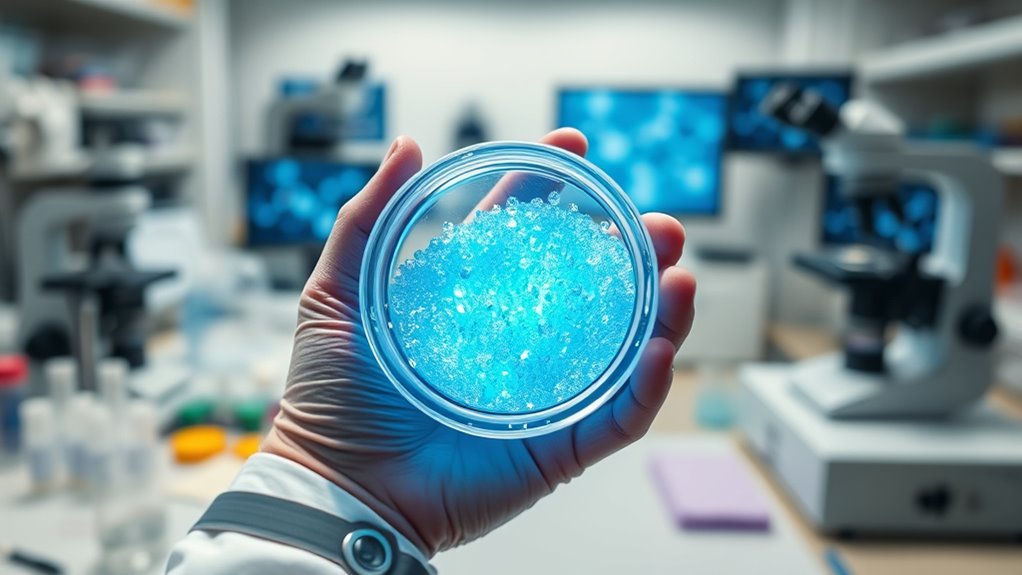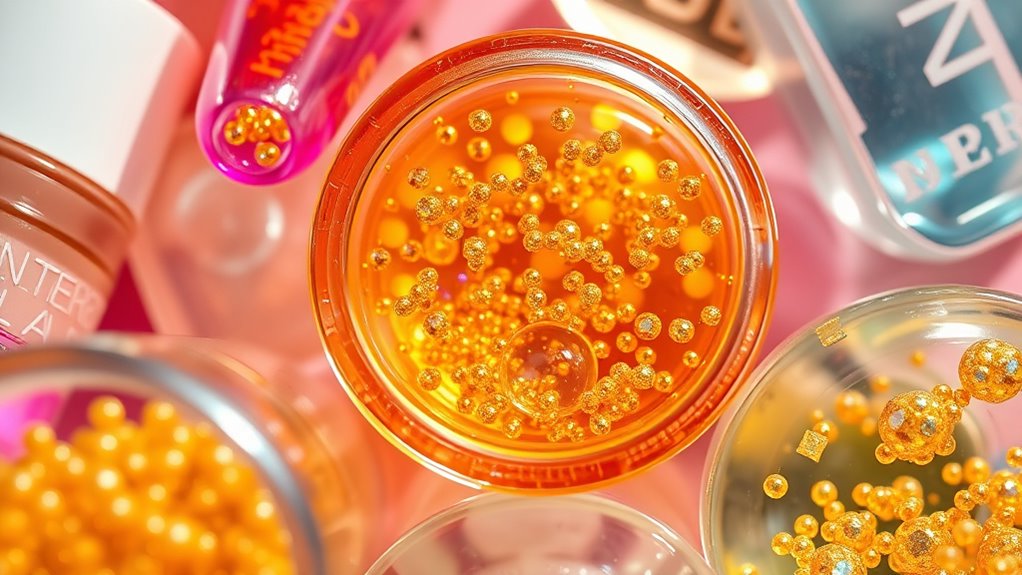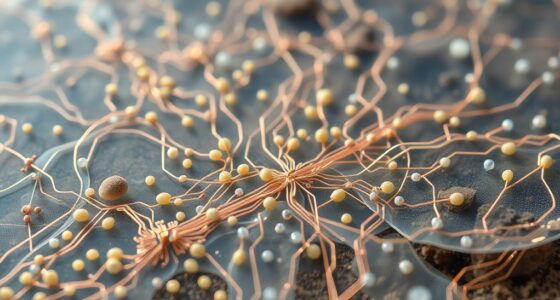Nanomaterials in everyday products provide benefits like improved UV protection, durability, and enhanced performance in items such as sunscreens, cosmetics, and electronics. They make products lighter, stronger, and longer-lasting. However, they also pose health and environmental risks, such as lung issues, toxicity, and pollution, due to their tiny size and ability to penetrate biological barriers. If you want to understand how these innovations balance benefits and risks, keep exploring more details.
Key Takeaways
- Nanomaterials enhance product performance, such as UV protection in sunscreens and durability in coatings, offering improved functionality.
- They enable lighter, stronger, and more efficient consumer items like electronics, textiles, and packaging.
- Potential health risks include inhalation, skin exposure, and deep tissue penetration, which may cause respiratory and long-term health issues.
- Environmental concerns involve nanoparticle persistence, bioaccumulation, and impacts on soil, water, and wildlife ecosystems.
- Responsible regulation, ongoing safety research, and transparent industry practices are essential to mitigate risks and ensure consumer safety.
Common Uses of Nanomaterials in Consumer Products

Nanomaterials have become increasingly common in consumer products, enhancing their performance and functionality. You’ll find nanoparticles in sunscreens, where titanium dioxide and zinc oxide make products transparent while offering better UV protection.
In cosmetics, nanomaterials improve texture and extend shelf life. Pharmaceuticals use nanomaterials to deliver drugs more effectively, and dietary supplements may contain engineered nanoparticles to boost absorption.
Even shampoos and soaps incorporate nanomaterials to enhance formulation. In textiles and apparel, nanotechnology creates stain-resistant fabrics, waterproof clothing, and smart garments with embedded electronics.
Household items like self-cleaning windows, anti-graffiti paints, and scratch-resistant glasses rely on nanocoatings. Electronics, from smartphones to batteries, incorporate nanomaterials for better sensors, displays, and power efficiency.
Food packaging with nanomaterials helps preserve freshness and improve durability. Nanoparticles in food packaging can also enable real-time detection of spoilage or contamination, providing an additional layer of safety for consumers. The safety and regulation of nanomaterials in consumer products continue to evolve as research advances.
Advantages of Incorporating Nanotechnology

Incorporating nanotechnology offers numerous advantages that substantially enhance the performance and functionality of materials and products. You gain lighter, more durable items thanks to increased strength-to-weight ratios, while wear-resistant nanostructures extend product lifespans. Graphene, a carbon allotrope harder than steel and lighter than aluminum, exemplifies this benefit by providing exceptional strength and conductivity in various applications. Tailored reactivity optimizes performance in specific environments, and improved electrical conductivity boosts electronics and coatings. Nanofiltration membranes enable precise molecular separation, improving filtration systems. In energy, nanomaterials lead to more efficient solar cells, catalysts, and energy storage, reducing overall consumption. Medical applications benefit from targeted drug delivery and advanced diagnostics, allowing treatments to be more precise and less invasive. Additionally, sustainable manufacturing becomes more feasible with atomically precise processes, minimizing waste.
Potential Health and Environmental Risks

Have you ever considered the potential health and environmental risks associated with nanomaterials? Exposure to nanoparticles can enter your body through inhalation, causing lung inflammation, respiratory diseases, and fibrosis.
Inhaled NPs may penetrate deep into lung tissue and the bloodstream, potentially impacting heart health and increasing cardiovascular risks. Animal studies with silver nanomaterials show decreased lung function and tissue inflammation.
NPs’ size, shape, and surface chemistry influence their toxicity. Chronic exposure to airborne nanoparticles like diesel soot has been linked to higher rates of heart and lung problems.
Environmentally, nanomaterials can persist and accumulate, harming soil, water, and wildlife. They may disrupt ecosystems, affect aquatic and terrestrial organisms, and bioaccumulate in food chains. Their ability to cross biological barriers like the blood-brain barrier raises additional concerns about neural toxicity. These risks highlight the importance of careful regulation and ongoing research.
Types of Nanomaterials and Their Functions

Various types of nanomaterials are now common in everyday consumer products, each serving specific functions based on their unique properties. Silver nanoparticles, for example, provide antimicrobial coatings that prevent bacteria and viruses on surfaces, while also making textiles odor-resistant by inhibiting microbial growth. Silver nanoparticles are also used in wound dressings due to their ability to promote faster healing by reducing infection risk. The use of nanomaterials in textiles enhances the durability and functionality of clothing and fabrics. Silica nanoparticles are used in fabrics to create stain-resistant features, making cleaning easier. Titanium dioxide (TiO₂) is a key ingredient in sunscreens and cosmetics for UV protection. Carbon nanotubes enhance the strength and stiffness of sports equipment like tennis rackets and bicycles, improving performance. Nanocomposites are integrated into scratch-resistant coatings for eyewear, offering durability. These nanomaterials enable products to deliver advanced functionalities, making daily life more convenient, protected, and efficient.
Trends in Market Adoption and Product Availability

The market for nanomaterials is experiencing rapid growth, driven by increasing adoption across multiple industries such as healthcare, electronics, and renewable energy. In 2023, the global market was valued at USD 12.42 billion and is projected to reach USD 48.3 billion by 2033, with a CAGR of around 15%. The industry is highly competitive, with key players focusing on innovation and strategic partnerships. You’ll see nanomaterials widely used in healthcare for drug delivery and diagnostics, and in electronics for semiconductors and sensors. The automotive and aerospace sectors adopt lightweight, durable nanomaterials, while renewable energy benefits from improved energy storage and solar technologies. Product availability is expanding, with nanoparticles, nanotubes, and nanofibers becoming essential in various applications. Despite regulatory challenges, ongoing innovations and increasing industry investments continue to boost market adoption and product accessibility, especially as nanomaterial safety assessments are more thoroughly developed to address potential risks.
Future Developments and Innovations in Nanotech

Advancements in nanotechnology are poised to revolutionize multiple fields, building on the growing market adoption seen in recent years. Quantum nanotech is pushing boundaries with nanoscale qubits, enabling more powerful, stable quantum computers, and ultra-sensitive sensors for cryptography and measurement. You’ll see integration into secure communication systems and progress in 2D materials like graphene to extend quantum coherence. Meanwhile, nanomedicine advances target cancer with nanoparticle drug delivery and improve early diagnosis with nanoscale imaging agents. Energy innovations include high-efficiency solar cells, fast-charging batteries, and nanogenerators powering wearables. These breakthroughs will enhance durability, performance, and sustainability across industries. Ongoing research continues to unlock new possibilities, promising even more transformative applications in the near future.
Balancing Benefits and Safety Considerations

While nanomaterials offer significant benefits in enhancing product performance and sustainability, balancing these advantages with safety concerns is essential. You need to carefully weigh their ability to improve durability, UV protection, and drug delivery against potential environmental and health risks. Indoor air quality can be affected by nanomaterials that become airborne, emphasizing the need for careful regulation and handling. Nanoparticles can easily enter air, water, and soil, harming ecosystems and disrupting biodiversity. Their small size allows them to penetrate biological barriers, raising toxicity concerns and possible long-term health effects, including respiratory issues and accumulation in the body. To minimize risks, ongoing research, responsible manufacturing, and transparent regulation are crucial. Collaborations among scientists, regulators, and industry can ensure safe innovation.
Frequently Asked Questions
How Can Consumers Identify Nanomaterial-Based Products Easily?
You can identify nanomaterial-based products by checking labels for terms like “nano,” “nanoparticles,” or “engineered nanomaterials.” Look for specific symbols or phrases indicating nanoscale ingredients, especially on cosmetics and textiles.
Use online resources and consumer guides to verify claims. Keep an eye on packaging that highlights advanced features like increased durability or UV protection, but remember, visual cues alone aren’t reliable without proper labeling or scientific confirmation.
Are There Effective Regulations Governing Nanomaterials in Everyday Items?
You might wonder if regulations effectively govern nanomaterials in products. Currently, regulations like REACH and CLP cover nanomaterials, but gaps remain, such as volume thresholds and lack of mandatory labeling.
Manufacturers often don’t disclose nanomaterials, making transparency tough. While some agencies are developing standards and calling for stricter rules, overall, oversight isn’t fully extensive, leaving consumers uncertain about the safety and presence of nanomaterials in everyday items.
What Long-Term Health Effects Are Associated With Nanomaterial Exposure?
Oh, so you think nanomaterials are just tiny, harmless additions? Think again. Long-term exposure can lead to serious health issues like lung and heart problems, organ damage, immune disruptions, and even cancer.
These particles can cross barriers and accumulate in your body, causing inflammation and cellular harm over time. So, you might be quietly risking your health with everyday products, all while assuming they’re safe because they’re so small.
How Do Nanomaterials Impact Environmental Ecosystems Over Time?
You might wonder how nanomaterials affect ecosystems long-term. Over time, they can contaminate soil and water through runoff, wind, or waste, accumulating mainly in sediments and soils.
This buildup harms soil creatures, plants, and aquatic life by causing toxicity, oxidative stress, and disrupting food webs. Bioaccumulation can lead to long-lasting environmental risks, making it essential to understand their fate to develop effective regulations and protect ecosystems.
Can Nanomaterials Be Safely Disposed of or Recycled?
You wonder if nanomaterials can be safely disposed of or recycled. Picture a delicate balance—on one side, strict disposal practices prevent environmental harm; on the other, recycling remains limited due to technical challenges.
You must follow hazardous waste protocols, use PPE during cleanup, and label waste clearly.
While recycling options are evolving, current methods focus on reclaiming base materials, emphasizing caution to protect ecosystems and human health.
Conclusion
As you explore nanomaterials in everyday products, remember they’re present in over 1,000 consumer goods today. While they offer incredible benefits like improved durability and performance, risks remain, especially with potential health and environmental impacts. Staying informed helps you make safer choices. Balancing innovation with safety is key to harnessing nanotechnology’s full potential without compromising your well-being or the planet’s health.









